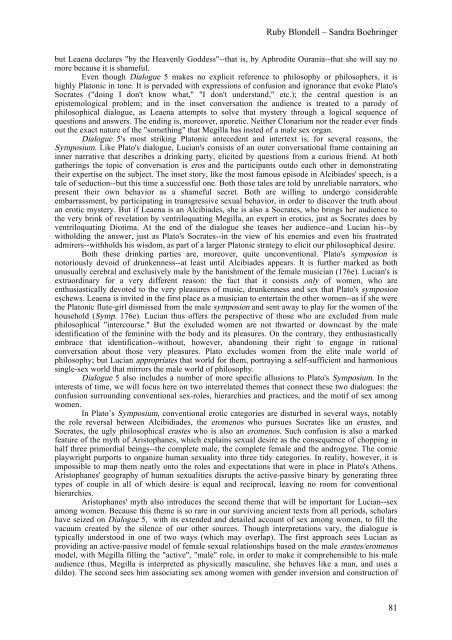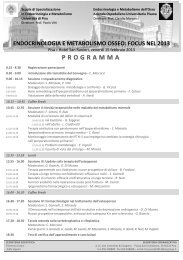Create successful ePaper yourself
Turn your PDF publications into a flip-book with our unique Google optimized e-Paper software.
Ruby Blondell – Sandra Boehringer<br />
but Leaena declares "by the Heavenly Goddess"--that is, by Aphrodite Ourania--that she will say no<br />
more because it is shameful.<br />
Even though Dialogue 5 makes no explicit reference to philosophy or philosophers, it is<br />
highly Platonic in tone. It is pervaded with expressions of confusion and ignorance that evoke Plato's<br />
Socrates ("doing I don't know what," "I don't understand," etc.); the central question is an<br />
epistemological problem; and in the inset conversation the audience is treated to a parody of<br />
philosophical dialogue, as Leaena attempts to solve that mystery through a logical sequence of<br />
questions and answers. The ending is, moreover, aporetic. Neither Clonarium nor the reader ever finds<br />
out the exact nature of the "something" that Megilla has insted of a male sex organ.<br />
Dialogue 5's most striking Platonic antecedent and intertext is, for several reasons, the<br />
<strong>Symposium</strong>. Like Plato's dialogue, Lucian's consists of an outer conversational frame containing an<br />
inner narrative that describes a drinking party, elicited by questions from a curious friend. At both<br />
gatherings the topic of conversation is eros and the participants outdo each other in demonstrating<br />
their expertise on the subject. The inset story, like the most famous episode in Alcibiades' speech, is a<br />
tale of seduction--but this time a successful one. Both those tales are told by unreliable narrators, who<br />
present their own behavior as a shameful secret. Both are willing to undergo considerable<br />
embarrassment, by participating in transgressive sexual behavior, in order to discover the truth about<br />
an erotic mystery. But if Leaena is an Alcibiades, she is also a Socrates, who brings her audience to<br />
the very brink of revelation by ventriloquating Megilla, an expert in erotics, just as Socrates does by<br />
ventriloquating Diotima. At the end of the dialogue she teases her audience--and Lucian his--by<br />
witholding the answer, just as Plato's Socrates--in the view of his enemies and even his frustrated<br />
admirers--withholds his wisdom, as part of a larger Platonic strategy to elicit our philosophical desire.<br />
Both these drinking parties are, moreover, quite unconventional. Plato's symposion is<br />
notoriously devoid of drunkenness--at least until Alcibiades appears. It is further marked as both<br />
unusually cerebral and exclusively male by the banishment of the female musician (176e). Lucian's is<br />
extraordinary for a very different reason: the fact that it consists only of women, who are<br />
enthusiastically devoted to the very pleasures of music, drunkenness and sex that Plato's symposion<br />
eschews. Leaena is invited in the first place as a musician to entertain the other women--as if she were<br />
the Platonic flute-girl dismissed from the male symposion and sent away to play for the women of the<br />
household (Symp. 176e). Lucian thus offers the perspective of those who are excluded from male<br />
philosophical "intercourse." But the excluded women are not thwarted or downcast by the male<br />
identification of the feminine with the body and its pleasures. On the contrary, they enthusiastically<br />
embrace that identification--without, however, abandoning their right to engage in rational<br />
conversation about those very pleasures. Plato excludes women from the elite male world of<br />
philosophy; but Lucian appropriates that world for them, portraying a self-sufficient and harmonious<br />
single-sex world that mirrors the male world of philosophy.<br />
Dialogue 5 also includes a number of more specific allusions to Plato's <strong>Symposium</strong>. In the<br />
interests of time, we will focus here on two interrelated themes that connect these two dialogues: the<br />
confusion surrounding conventional sex-roles, hierarchies and practices, and the motif of sex among<br />
women.<br />
In Plato’s <strong>Symposium</strong>, conventional erotic categories are disturbed in several ways, notably<br />
the role reversal between Alcibidiades, the eromenos who pursues Socrates like an erastes, and<br />
Socrates, the ugly philosophical erastes who is also an eromenos. Such confusion is also a marked<br />
feature of the myth of Aristophanes, which explains sexual desire as the consequence of chopping in<br />
half three primordial beings--the complete male, the complete female and the androgyne. The comic<br />
playwright purports to organize human sexuality into three tidy categories. In reality, however, it is<br />
impossible to map them neatly onto the roles and expectations that were in place in Plato's Athens.<br />
Aristophanes' geography of human sexualities disrupts the active-passive binary by generating three<br />
types of couple in all of which desire is equal and reciprocal, leaving no room for conventional<br />
hierarchies.<br />
Aristophanes' myth also introduces the second theme that will be important for Lucian--sex<br />
among women. Because this theme is so rare in our surviving ancient texts from all periods, scholars<br />
have seized on Dialogue 5, with its extended and detailed account of sex among women, to fill the<br />
vacuum created by the silence of our other sources. Though interpretations vary, the dialogue is<br />
typically understood in one of two ways (which may overlap). The first approach sees Lucian as<br />
providing an active-passive model of female sexual relationships based on the male erastes/eromenos<br />
model, with Megilla filling the "active", "male" role, in order to make it comprehensible to his male<br />
audience (thus, Megilla is interpreted as physically masculine, she behaves like a man, and uses a<br />
dildo). The second sees him associating sex among women with gender inversion and construction of<br />
81




